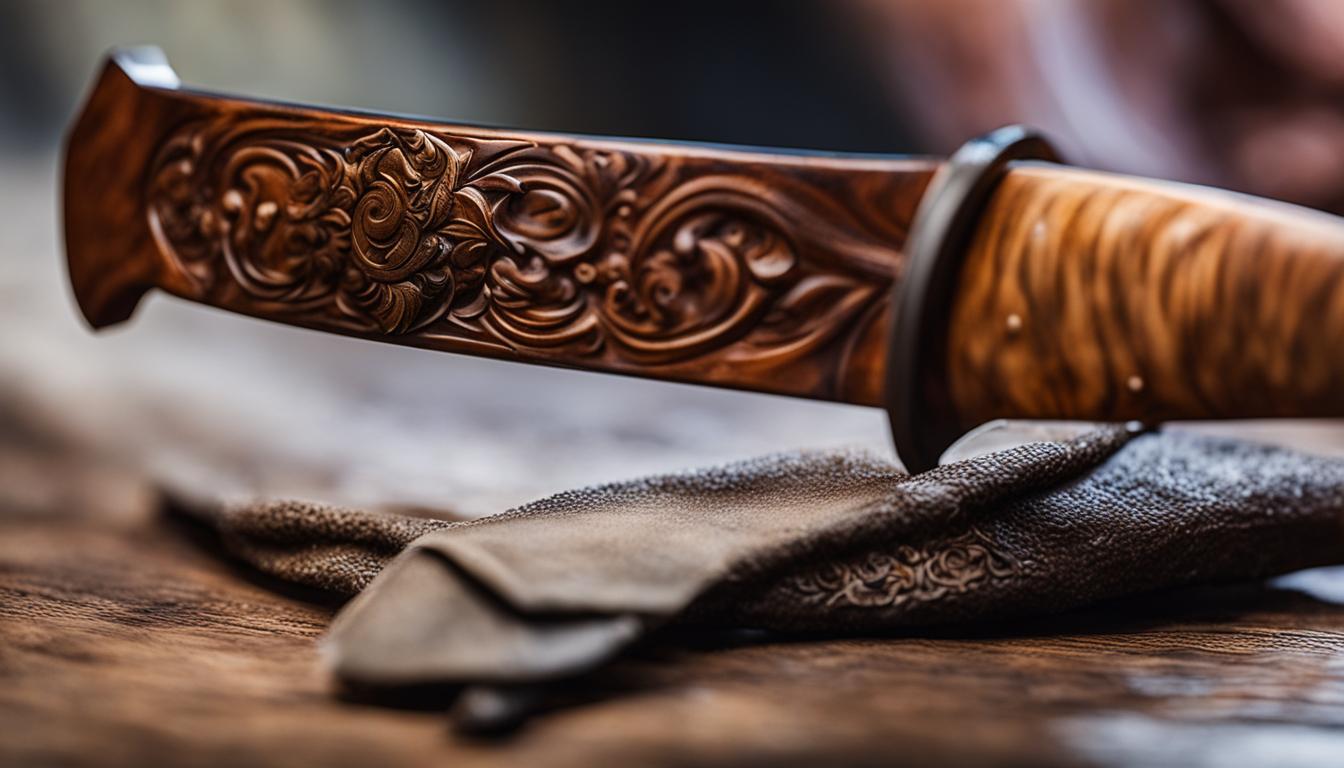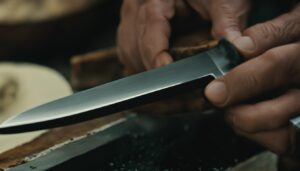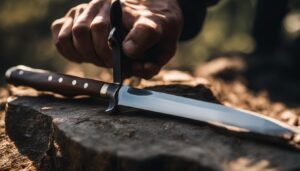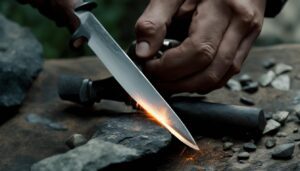Proper maintenance practices are crucial for the longevity, sharpness, and overall performance of your hunting knife. As a hunting enthusiast, it’s important to understand how to clean and maintain your hunting knife handle effectively. By following these handle cleaning tips, you can ensure that your knife is always in top condition, ready for your next hunting adventure.
Key Takeaways:
- Regularly clean the blade, handle, and metal components with warm water and mild soap or detergent.
- Pay attention to hard-to-reach areas and rinse and dry the knife thoroughly.
- Lubricate the blade, pivot point, and moving parts with a thin layer of lubricating oil.
- Use a wood conditioner or oil for wooden handles.
- Sharpen the blade using a quality sharpening stone or system, maintaining a consistent angle.
By following these cleaning and maintenance tips, you can extend the lifespan of your hunting knife and ensure that it performs at its best in the field. Taking care of your knife is essential for a successful hunting experience.
The Importance of Regular Cleaning
Proper cleaning of your hunting knife is a crucial step in its maintenance. Regular cleaning ensures that debris and residue from previous use are removed, preventing them from affecting the knife’s performance and longevity. By following a few simple steps, you can keep your hunting knife clean and in optimal condition for future use.
After each use, it is essential to thoroughly clean your hunting knife to remove any dirt, blood, or other substances that may have accumulated on the blade, handle, or metal components. Start by rinsing the blade with warm water to remove any loose particles. Then, use a mild soap or detergent and a soft brush to scrub the blade, handle, and metal components, paying close attention to hard-to-reach areas.
Once you have scrubbed the knife, rinse it again with warm water to ensure all soap residue is removed. Finally, dry the knife carefully with a clean towel or cloth to prevent moisture damage. It is important to ensure the knife is completely dry before storing it to prevent rust or corrosion.
Regular cleaning of your hunting knife not only helps maintain its appearance but also plays a significant role in its overall performance and longevity. By dedicating a few minutes to clean your knife after each use, you can ensure that it will be ready for your next hunting adventure.
Lubrication and Rust Prevention
Proper lubrication is essential for preventing rust and maintaining the performance and longevity of your hunting knife. By regularly applying a thin layer of lubricating oil or specialized knife oil, you can protect the blade, pivot point, and other moving parts from corrosion and ensure smooth operation.
When it comes to choosing the right lubricant for your knife, consider opting for a high-quality knife oil that is specifically designed for outdoor use. These oils are formulated to provide long-lasting protection against rust and other environmental factors. Avoid using regular household oils, as they may attract dirt and debris, ultimately compromising the functionality of your knife.
To apply the lubricant, simply put a small amount onto a clean cloth or your finger and rub it onto the blade, pivot point, and any other areas that require lubrication. Make sure to wipe off any excess oil to prevent the accumulation of dirt and grime. Additionally, periodically check the condition of your knife’s wooden handle and apply a wood conditioner or oil to prevent it from drying out and cracking.
Remember, proper lubrication is a crucial step in maintaining the performance and lifespan of your hunting knife. By regularly applying lubricating oil and taking care of the handle, you can ensure that your knife remains in top-notch condition and ready to tackle any hunting adventure.
Benefits of Proper Lubrication:
- Prevents rust and corrosion
- Ensures smooth operation of the blade and moving parts
- Protects the handle from drying out and cracking
- Extends the lifespan of your hunting knife
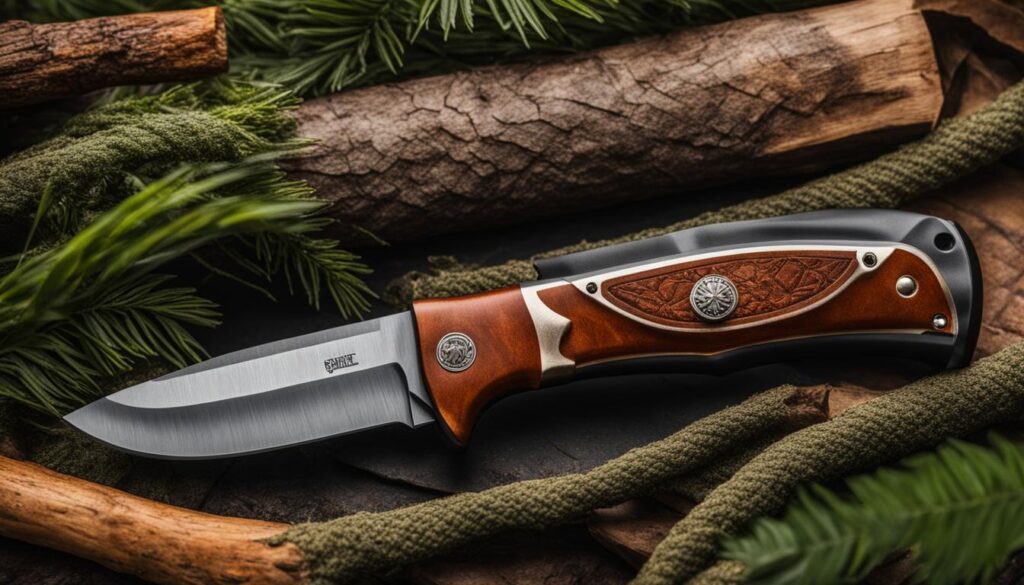
| Lubrication Tips | Rust Prevention Techniques |
|---|---|
| Choose a high-quality knife oil | Avoid storing the knife in a leather sheath for extended periods |
| Apply a thin layer of lubricant to the blade, pivot point, and moving parts | Regularly inspect the knife for any signs of corrosion |
| Wipe off excess oil to prevent the accumulation of dirt and debris | Store the knife in a clean, dry location |
| Use a wood conditioner or oil to maintain the handle’s condition | Consider using a sheath made of moisture-resistant materials |
Blade Sharpening Techniques
Properly sharpening the blade of your hunting knife is essential for maintaining its cutting performance and ensuring a clean, precise cut. Here are some effective blade sharpening techniques to keep your knife in optimal condition:
1. Use a Sharpening Stone
The most common method for sharpening a hunting knife blade is using a sharpening stone. Choose a high-quality stone with a coarse grit for initial sharpening and a finer grit for polishing. Start by wetting the stone and placing it on a stable surface. Hold the knife at a consistent angle, usually between 15 to 20 degrees, and swipe the blade across the stone in a smooth, sweeping motion. Repeat this process, alternating sides, until you achieve the desired sharpness.
2. Maintain a Consistent Angle
Consistency is key when sharpening your knife blade. To maintain a consistent angle, you can use a sharpening guide or simply practice holding the knife at the same angle throughout the sharpening process. This ensures that the blade is sharpened evenly and avoids any uneven cutting edges.
3. Hone the Blade with a Strop
After sharpening the blade on a stone, it’s important to hone the edge for a finer, sharper finish. A leather strop is an excellent tool for this purpose. Apply a small amount of honing compound to the strop and drag the knife blade across the leather surface at the same angle used during sharpening. This final step helps remove any burrs or imperfections, resulting in a polished and razor-sharp edge.
| Sharpening Method | Pros | Cons |
|---|---|---|
| Sharpening Stone | – Versatile and widely available – Allows precise control over sharpening angle |
– Requires practice to achieve desired results – Can be time-consuming |
| Sharpening System | – Provides consistent angle control – Easy to use for beginners |
– Requires the purchase of a sharpening system – Less portable than a sharpening stone |
| Guided Rods | – Simple and portable – Allows for quick touch-ups |
– Limitations in sharpening angles – May not be as effective for heavily damaged blades |
Remember to take your time and maintain a steady hand while sharpening your hunting knife blade. With practice and patience, you’ll be able to achieve a razor-sharp edge that will enhance your cutting performance in the field.
Proper Storage and Sheath Care
When it comes to maintaining your hunting knife, proper storage and sheath care are crucial aspects to consider. By taking the necessary steps to protect your knife from rust, moisture, and damage, you can ensure its longevity and reliable performance. In this section, I will discuss the essential guidelines for storing your hunting knife and maintaining its sheath.
Storing Your Hunting Knife
Choosing the right storage location for your hunting knife is paramount to prevent rust and other forms of damage. Ideally, you should store your knife in a clean, dry area to minimize moisture exposure. Avoid storing it in humid environments or near sources of water, as this can lead to corrosion.
Additionally, it’s essential to store the knife separately from its sheath. While leather sheaths are commonly used, they can retain moisture and promote rust. Therefore, it’s recommended to remove the knife from the sheath when not in use and store them separately. Consider investing in a sheath made from moisture-resistant materials like nylon or Kydex to provide additional protection to your knife.
Sheath Care and Maintenance
To ensure the longevity of your knife sheath, regular care and maintenance are necessary. Here are a few tips to keep your sheath in optimal condition:
- Clean the sheath regularly by wiping it with a damp cloth to remove any dirt or debris.
- Avoid exposing the sheath to excessive heat or direct sunlight as it can cause the material to warp or degrade.
- If your sheath becomes wet, allow it to air dry completely before storing the knife.
- Inspect the sheath periodically for any signs of wear, such as loose stitches or tears, and repair or replace it if necessary.
By following these storage and sheath care guidelines, you can protect your hunting knife from corrosion and ensure that it remains in optimal condition for your next hunting adventure.
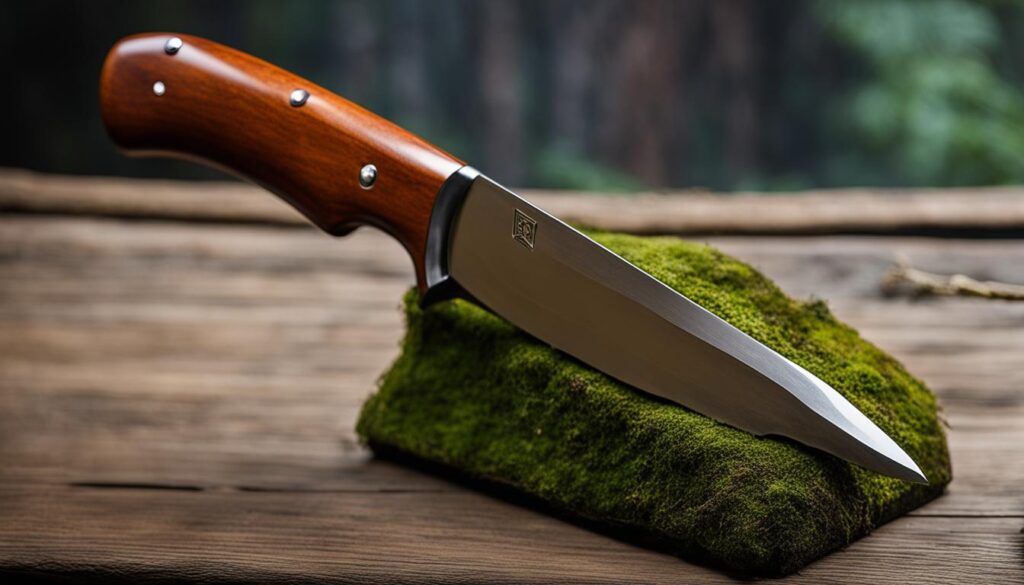

Table: Comparing Sheath Materials
| Sheath Material | Pros | Cons |
|---|---|---|
| Nylon | Durable, lightweight, moisture-resistant | May not provide a snug fit, can accumulate dirt |
| Kydex | Excellent retention, impact-resistant, waterproof | Can be bulky, less aesthetically pleasing |
| Leather | Classic look, flexible, provides a snug fit | Prolonged exposure to moisture can lead to rust, requires regular maintenance |
Table: Comparing different sheath materials and their pros and cons.
Conclusion
Properly caring for your hunting knife is essential to ensure its longevity and maintain its performance. By following these knife maintenance tips, you can keep your blade in optimal condition and ready for any hunting adventure.
To begin, regular cleaning is crucial to remove debris and residue from your knife. Rinse the blade with warm water and use a mild soap or detergent to scrub the blade, handle, and metal components. Pay attention to hard-to-reach areas, and don’t forget to rinse and dry the knife thoroughly to prevent moisture damage.
Additionally, proper lubrication is essential to protect your hunting knife from rust and to ensure smooth operation. Apply a thin layer of lubricating oil to the blade, pivot point, and other moving parts. Wipe off any excess oil to prevent attracting dirt or debris. For wooden handles, consider treating them with a wood conditioner or oil to prevent drying out.
Lastly, storing your hunting knife correctly is vital. Keep it in a clean, dry location to avoid rust or damage. If your knife has a sheath, make sure it is clean and dry before inserting the knife. It’s also advisable to use a sheath made of moisture-resistant materials to prevent corrosion. Avoid storing the knife in a leather sheath for extended periods as it can retain moisture.
By adhering to these knife maintenance practices, you can prolong the life of your hunting knife and ensure it remains a reliable tool in the field. Remember to regularly clean, lubricate, sharpen, and store your knife for optimal performance. Happy hunting!
FAQ
How often should I clean my hunting knife handle?
It is recommended to clean your hunting knife handle after each use to remove debris and residue.
What should I use to clean the handle of my hunting knife?
You can rinse the handle with warm water and use mild soap or detergent with a soft brush to scrub away dirt and grime.
How should I clean hard-to-reach areas on the knife handle?
Pay extra attention to hard-to-reach areas by using a small brush or toothbrush to ensure thorough cleaning.
How do I dry the hunting knife handle after cleaning?
After rinsing, make sure to dry the knife handle carefully to prevent moisture damage.
Why is lubrication important for a hunting knife handle?
Lubricating the handle helps protect it from rust and ensures smooth operation of the knife.
What kind of oil should I use to lubricate the hunting knife handle?
You can use a thin layer of specialized knife oil or lubricating oil to protect the handle.
How do I prevent wooden handles from drying out?
To prevent drying out, treat wooden handles with a wood conditioner or oil.
How can I sharpen the blade of my hunting knife?
Use a quality sharpening stone or system, maintaining a consistent angle while sharpening the blade.
What grit should I start with when sharpening the hunting knife blade?
Begin with a coarse grit to remove nicks or dullness, then progress to finer grits for a polished edge.
How do I store my hunting knife to prevent damage?
Store the knife in a clean, dry location to prevent rust or other forms of damage.
Can I store my hunting knife in a leather sheath?
It is not recommended to store the knife in a leather sheath for extended periods as it can retain moisture.
How often should I inspect my hunting knife for wear or damage?
It is important to regularly inspect your hunting knife for wear, loose screws, or any signs of damage.
